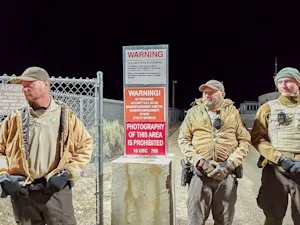
Sarah Palin Trial Shocker: Verdict, Drama, and One Viral Post
Sarah Palin prepares for her Super Bowl commercial, 2009. Photo by Airman 1st Class Kristin High. Public domain.
Sarah Palin didn't just lose a high-profile court case against The New York Times. She launched a comeback. After years in political obscurity, the former Alaska governor and 2008 vice presidential lightning rod just yanked herself back into the headlines — courtroom-style. Her case may have crashed and burned, but the drama gave her a second chance at center stage.
Why Palin Sued the Times — And Why It Matters
This wasn't just a routine legal scuffle. In 2017, The New York Times ran an editorial on gun control following the shooting of Republican Rep. Steve Scalise. In it, the editorial referenced a map from Sarah Palin's political action committee that used crosshairs to identify targeted Democratic congressional districts — one of which belonged to Rep. Gabby Giffords, who was shot in 2011. The paper falsely stated that there was a link between that map and the shooting.
Less than 14 hours later, the Times corrected the piece, clarifying that no link had been established. Still, Palin sued for defamation, arguing that the mistake harmed her reputation and triggered a spike in threats against her safety.
Palin first took the paper to court in 2022. She lost. But in a surprise twist, the case was revived in 2024 after an appeals court ruled the original trial was mishandled. That led to the 2025 retrial — same judge, same facts, and the same final result: another defeat for Palin.
The Trial That Brought the Circus Back to Town
This time around, the appeals court allowed the jury to hear previously excluded details, including that former New York Times editor James Bennet is the brother of Democratic Sen. Michael Bennet — a point Palin's legal team used to imply bias. The case once again revolved around the question of "actual malice" — a high legal bar requiring Palin to prove the paper either knew the statement was false or acted with reckless disregard for the truth, according to The Guardian.
The jury needed just two hours to reach a verdict: The New York Times was not liable. Palin's claim failed to clear the legal hurdle. According to the verdict, the editorial may have included an error, but it was not malicious — it was simply a mistake.
So Why Does This Still Matter?
Because for Palin — and the broader movement that sees the media as a political adversary — this wasn't only about winning damages. According to The Guardian, it was about challenging what she calls "fake news" and dragging one of the country's most prominent newspapers into the spotlight for its mistakes.
The 2025 retrial reignited her long-standing feud with the press and gave her a platform to echo complaints shared by political allies and supporters across the country. She left the courtroom disappointed, but not defeated. She told reporters that she gets to "go home to a beautiful family of five kids and grandkids and a beautiful property and get on with life. And that's nice," as reported by NBC News. She then took to social media to call out the media again.
Flashback: The Wild Ride of Sarah Palin
For anyone under 30, here's your refresher. Sarah Palin rose to national fame when John McCain tapped her as his running mate in the 2008 presidential election. She was the first female Republican on a national ticket, and she made sure the country knew it. With her Alaska roots, no-nonsense tone, and over-the-top media moments, she carved out an image unlike any other politician.
Palin's resume includes:
- Governing Alaska from 2006 to 2009.
- Being a conservative icon for the Tea Party movement.
- Repeatedly clashing with the mainstream press.
- Turning her fame into reality television, book deals, and national speaking tours.
- A failed congressional run in 2022, years after leaving public office.
She's also known for some unforgettable moments, including a viral interview where she couldn't name a single newspaper she read, a speech that, according to Carbon Brief, included the phrase "drill, baby, drill," and her reality show "Sarah Palin's Alaska."
What This Case Meant for Free Speech
Palin's team tried to argue that the New York Times acted recklessly and should pay for it. But under current law, public figures like her face enormous difficulty winning defamation suits. The burden of proof — showing that a publisher knowingly printed false information or did so with reckless disregard — is notoriously hard to meet.
This case didn't change that. The appeals court's decision to reinstate the case did raise some eyebrows, especially given the criticism of the original trial judge's handling of the first verdict. But the retrial only reaffirmed the strength of existing legal protections for publishers making honest mistakes.
That means no new precedent was set. The landmark Supreme Court ruling from 1964 — "New York Times v. Sullivan" — remains the gold standard for protecting press freedom. And though some on the political right had hoped Palin's case could challenge or even overturn that standard, the jury's quick dismissal shut the door.
What Happens Next?
Palin's legal team says they're still weighing whether to appeal again. But with two juries and one judge rejecting the claim, it's unlikely she'll get a fourth try.
In the end, the case gave Palin what she's always known how to grab — attention. Even as the verdict slipped out of her hands, the headlines pulled her back into the public eye.
And for a political figure who's long thrived on controversy, that might be the only victory she needed.
References: The New York Times didn't libel former Alaska Gov. Sarah Palin, jury finds | Sarah Palin's Long Goodbye | Sarah Palin loses retrial of defamation case against New York Times | 'Drill, baby, drill': The surprising history of Donald Trump’s fossil-fuel slogan
























